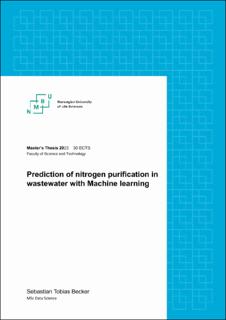| dc.description.abstract | Wastewater treatment plants are necessary for avoiding environmental pollution by humans. Last year the European Commission proposed a new directive with stricter requirements for wastewater treatment plants. To meet the proposed regulatory changes regarding the allowed amount of pollution, many wastewater treatment plants need expensive facility upgrades. These upgrades may increase land use. Additionally, the taxpayers will most likely have to pay for the expenses related to meet the new requirements for the wastewater treatment plants. One possible solution for reducing the cost and land use could be to optimize the processes used today with new technology. This study will investigate if it is possible to use machine learning to predict the amount of nitrate contained in the wastewater after denitrification. For this purpose, historical data from two different denitrification processes from one wastewater treatment plant is utilized. The first process dosed methanol based on measurements of nitrate, oxygen, and flow before denitrification, while the second process dosed methanol based on measurements of nitrate, oxygen, and flow before denitrification and previous nitrate out measurements. The data were collected between 30.11.2022 and 05.01.2023. One statistical approach and two machine learning models were tested for predicting the amount of nitrate contained in the wastewater after denitrification. The statistical method is a seasonal autoregressive integrated moving average with exogenous variables (SARIMAX) and the machine learning approaches are the long short term memory (LSTM) and extreme gradient boosting (XGBoost) algorithms. For the first process all models showed similar results with SARIMAX as the best model with an MSE, RMSE and MAE of 0.15, 0.39 and 0.29 respectively. For the second process the SARIMAX model outperformed the LSTM and XGBoost with MSE,RMSE and MAE of 2.09, 1.45 and 1.24 respectively. Our research show that it is significantly easier to get good performing models for process one than two. We are presenting some aspects which should be further investigated to obtain a solution that is ready to be put into use. | |
